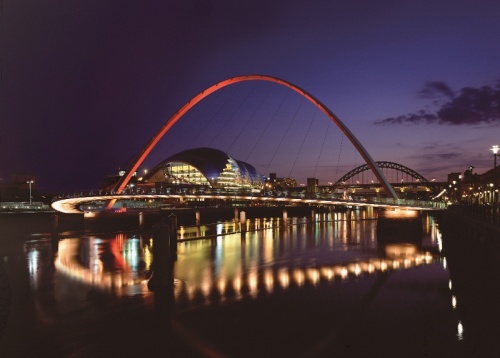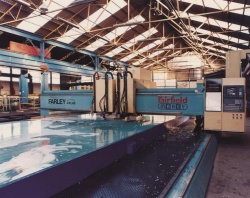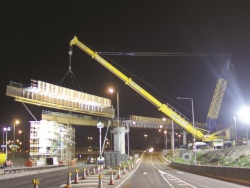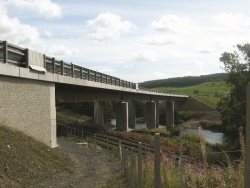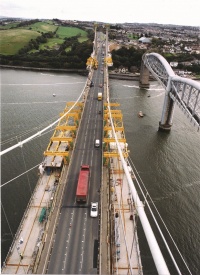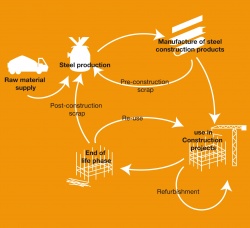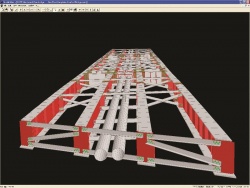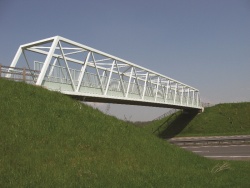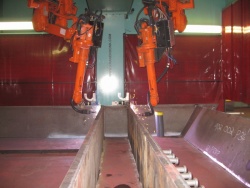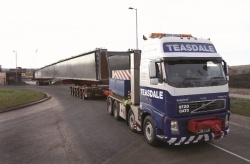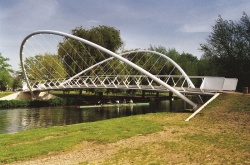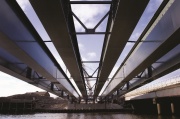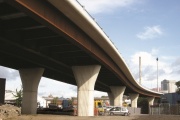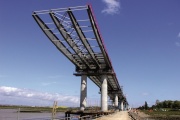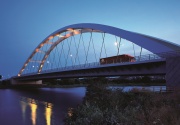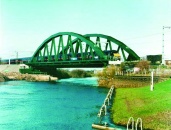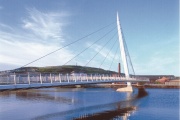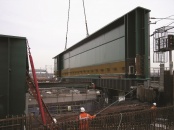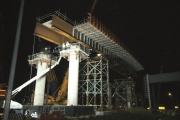Sustainable steel bridges
Steel is widely used around the world for the construction of bridges from the very large to the very small. It is a versatile and effective material that provides efficient and sustainable solutions. Steel scores well on all the sustainability measures, and offers a broad range of benefits addressing the economic, environmental, and social priorities of the ‘triple bottom line’ of sustainability.
The basic raw material (iron) is the most abundant of all the earth’s elements, and steel can be recycled indefinitely without any loss of property or performance. Sustainability is built into steel products all along the supply chain, from responsible sourcing of raw materials through a manufacturing process dedicated to continuous improvement to the production of modern and efficient bridges.
[top]Economic priorities
Steel has long been recognized as the economic option for a range of bridges, because it represents the most efficient use of resources. It dominates the markets for long span bridges, railway bridges, footbridges, and medium span highway bridges. It is now increasingly the choice for shorter span highway structures as well.
[top]Efficient use of resources
Structural steel is a high quality material that is readily available worldwide in various certified grades, in products of various shapes and sizes. Prefabrication of steelwork in controlled factory conditions leads to high quality work at minimum cost. The excellent quality control is achieved through a thorough testing regime at the steel mills and during the construction processes of cutting & drilling, fit-up, welding and painting. The quality assurance that is attained should give confidence to all clients and engineers who specify steel for their bridge project.
The high strength to weight ratio of steel minimises the structural weight of superstructures and thus minimises the substructure costs, which is particularly beneficial in poor ground conditions. Minimum self-weight is also an important factor in the cost of transporting and handling components. Use of steel facilitates shallow construction depths, which overcomes problems with headroom and flood clearances, and minimises the length and cost of approach embankments.
[top]Minimum disruption
Off-site prefabrication of steel components means that construction time on site, often in hostile environments, is minimised. The speed of bridge construction made possible by steel allows disruption to road and rail users to be kept to a minimum, if not eliminated, with significant positive knock-on effects for the UK economy. The relatively low weight of structural steel components permits the erection of large sections; in some circumstances complete bridges can be moved into position overnight.
A wide range of construction methods and sequences are available for steel bridges. They can be lifted, piece-by-piece, by cranes; they can be launched by sliding or rolling from the abutment; or they can be slid or transported into position. Steel offers flexibility in terms of erection sequence and certainty in terms of the programme. Components can be sized to suit access restrictions at the site and, once erected, the steel girders provide platforms for subsequent operations.
[top]Durability
Bridge owners increasingly value steel for its durability and low maintenance advantages.
Steel bridges now have a proven life span extending to well over 100 years. Steel has a predictable fatigue life and the structural elements are visible and accessible. Any signs of deterioration are readily apparent, without the need for extensive investigations. Corrosion is a surface effect, which rarely compromises the structural integrity of a bridge, and any problems may be swiftly addressed by repainting the affected areas.
Advances in coating technology and an industry commitment to the training of coating applicators mean that the latest protective systems are expected to last well beyond 30 years before requiring maintenance. Furthermore, the use of unpainted weathering steel, which requires almost no maintenance, is increasingly popular, as it is recognized as the ultimate low maintenance option for bridge construction.
[top]Adaptability
Steel bridges are readily adaptable to changes in road configuration and increased loading that would render other types of structure obsolete ahead of their original design lives.
One notable example is the Tamar suspension bridge in Plymouth, which needed widening and strengthening due to increased traffic loads and volumes. The solution was to replace the concrete deck with a new lightweight steel one, and add steel cantilever sections. The result was that the widened 5-lane bridge was only 25 tonnes heavier than the old 3-lane structure, and was able to accommodate 44 tonne trucks.
Steel bridges also lend themselves to easy and rapid strengthening or repair in the event of accidents, with well proven techniques like heat straightening ensuring that damaged structures are soon back in use.
[top]Environmental priorities
Nothing could be more natural or sustainable than to build our world with steel. Iron, the basic raw material, is the most abundant element on Earth. A compass points north because the iron content of the planet gives it polarity like a magnet. This virtually inexhaustible natural resource can be recycled indefinitely without loss of property or performance.
[top]Recycling and reuse
Steel is the most recycled construction material and choosing it for bridges represents a sustainable management of natural resources. When a steel bridge reaches the end of its useful life, the girders can be cut into manageable sizes to facilitate demolition, and returned to steelworks for recycling. Some 99% of structural steel either finds its way back into the steelmaking process where it is used to create new steel products or is reused. There is no degradation in the performance of recycled steel. Alternatively, component parts of steel bridges can be reused in other structures; entire bridges have been relocated and bridges can be designed with ease of future relocation in mind.
[top]Minimum CO2 and energy burdens
Designers and specifiers can use the appropriate steel manufacturer’s Environmental Product Declaration (EPD), assuming that they know where their steel product will be sourced from.
However, if the source of steel product is unknown, which is generally the case at the design stage, then it is recommended that an average value, reflecting a UK average consumption mix is used. This is because steel is a globally-traded commodity and therefore taking, for example, a UK average production value, is not representative of UK consumption.
The BCSA recommends the following UK average emissions factors for embodied carbon assessments of structural steelwork:
| Product | BS EN 15804[2] Modules | Whole Life Carbon | |
|---|---|---|---|
| Product stage | Recycling potential | ||
| Modules A1 to A3 | Module D | ||
| Structural steelwork | 1.74 | -0.93 | 0.81 |
EN 15804[2] states that the figures for the various modules should generally be reported separately, but offers no guidance on how to use the data to make decisions on a project. If decisions are made on a short-term cradle-to-gate or ‘product stage’ basis, then the figure of 1.74 would be used. However, if a more comprehensive long-term Whole Life Carbon basis is adopted, then the figure of 0.81 could be used, which is an aggregate of the tabulated modules A and D.
[top]Minimum waste
Offsite production in modern fabrication plants using state of the art CNC machinery integrated with CAD software ensures that waste is minimised, both during manufacture of steel elements and on site. Waste minimisation is promoted by good designs that minimise use of materials; the steel bridge industry provides a full range of technical back-up for designers to promote this aim.
[top]Lightweight construction
The lightweight nature of a steel bridge means that it leaves the lightest possible footprint. Minimum foundation works is desirable not only for cost reasons, but also to minimise the environmental impact. The excavation, transportation and disposal of arisings for substructures requires energy, creates CO2, and lorry movements are a nuisance for the local community. It is better to create minimum ground disturbance where possible, and steel helps to achieve this aim.
[top]Social priorities
Society gains in many ways from the benefits delivered by steel bridge solutions. Landmark steel bridges embody good design. They are economical and fast to build, and have stimulated the regeneration of many former industrial, dock and canalside areas.
[top]Sustainable communities
The off-site fabrication of steel bridges in a factory environment provides jobs for a workforce close to where they live. This benefits family life and promotes stable communities. Continuous investment in new plant and machinery, and the stable long-term nature of jobs in a steel fabrication factory, assist in the training of a specialist workforce. Such skills development both motivates the workforce and increases the efficiency of steel bridge construction.
[top]Health and safety
Steel bridges represent the superior option when health and safety is considered. Off-site fabrication means steel is safely manufactured in factory conditions. Automated production, using robotic welders, makes for safer working environments. Because the majority of construction work is off-site, the steel erection work on site is inherently safer, with far fewer trades and operatives involved and is faster, thus minimizing time working at height in hostile environments.
The British Constructional Steelwork Association has a continuous programme of research, education and publications aimed at improving the already highly creditable safety performance of the steel construction industry. The BCSA’s Safe Site Handover Certificate is an outstanding example of a modern safe working practice, and its BCSA Sustainability Charter, to which all member companies can sign up, represents another best practice initiative from the steel construction sector.
[top]Minimum impact
The lightweight nature of steel bridges, and the fact that the components are manufactured offsite means far fewer site visits from heavy vehicles, benefiting local communities. The typically rapid construction period for a steel bridge means that impacts on local people and businesses can be minimised.
[top]Aesthetically pleasing bridges
Steel has broad architectural possibilities. Steel bridges can be made to look light or reassuringly solid, and can be sculptured to any shape or form. The high surface quality of steel creates clean sharp lines and allows attention to detail. Modern fabrication methods can easily provide curvature in both plan and elevation. The painting of steelwork introduces colour and contrast, and repainting can change or refresh the appearance of the bridge.
Steel bridges are an essential feature of a country’s infrastructure and landscape. Few man-made structures combine the technical with the aesthetics in such an evocative way. Look closely at the next ‘landmark’ bridge you see; the chances are that it is made of steel.
[top]Case studies
[top]References
- ↑ UK average embodied carbon of structural steel, New Steel Construction, April 2021updated in May 2021
- ↑ 2.0 2.1 BS EN 15804:2012+A2:2019 Sustainability of construction works. Environmental product declarations. Core rules for the product category of construction products. BSI
[top]Resources
[top]See also
- Sustainable construction legislation, regulation and drivers
- Construction and demolition waste
- Recycling and reuse
- Life cycle assessment and embodied carbon




